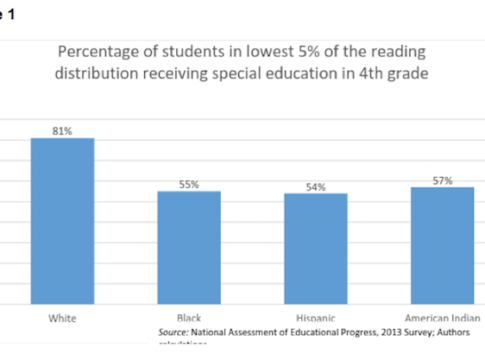On Top of the News
Study on Minorities in Special Education Proves Provocative
6/25/15 | Ed Week
Behind the Headline
Big Impact: Supreme Court Housing Decision Could Have Significant Effect on Education
6/21/15| Education Next blog
According to the conventional wisdom, minority students tend to be overrepresented in special ed because teachers are biased against them. Black students are 1.4 times more likely to be placed in special education than students of other races and ethnicities combined.
However, the authors of a new study say that minority students are less likely than similar white peers to be in one of five common disability categories—emotional disturbance, intellectual disability, “other health impairment,” specific learning disability, and speech and language impairment.
In an op-ed in the New York Times, the authors say
The real problem is that black children are underrepresented in special-education classes when compared with white children with similar levels of academic achievement, behavior and family economic resources.
As explained by Christina Samuels in Ed Week
In the study, the researchers looked at a national sample of children, but included not only race but a number of other variables that are connected to educational outcomes: English-language status, birth weight, insurance status, household income, and mother’s marital status, among others. They also controlled for the child’s academic achievement and behavior.
When the children were compared after accounting for those confounding factors, the probability for being identified for special education was always lower for minority students. [Study co-author Paul] Morgan explained that race may not be playing a role in special education identification, but that there are many negative factors for children that are associated with race. For example, black children may be more likely to be born at a low birth weight, or to be in low-income households. Morgan said that educators may also be avoiding identifying minorities for special education because they are concerned about tipping towards overidentification.
Michael K. Yudin, the assistant secretary for the office of special education and rehabilitative services at the U.S. Department of Education told Samuels that the findings do not change the view of the department that significant overrepresentation of minorities in special education is a real problem.
The use of “disparate impact” analysis by the U.S. Department of Education has been criticized by Ed Next’s Josh Dunn, most recently in “Big Impact: Supreme Court Housing Decision Could Have Significant Effect on Education.”
The Supreme Court ruled last week in a case relating to the Fair Housing Act that the law forbids policies that are designed and implemented without discriminatory intent but have some disproportionate effect (i.e., “disparate impact”) based on race. Dunn argues that the Office of Civil Rights in the U.S. Department of Education has been using “disparate impact analysis” to issue profoundly misguided policies on school discipline and school finance.
– Education Next





